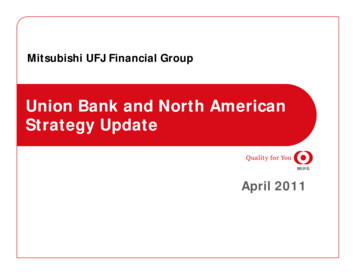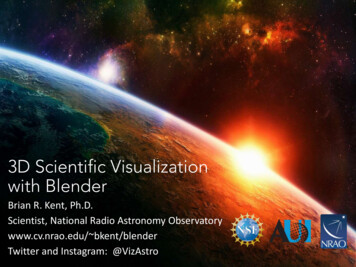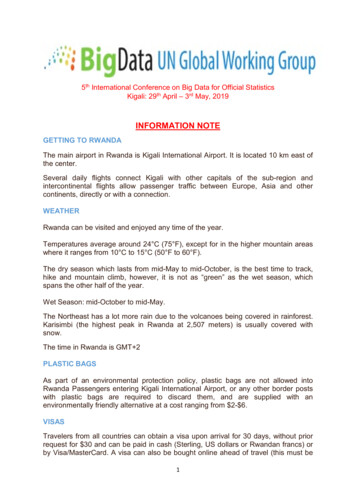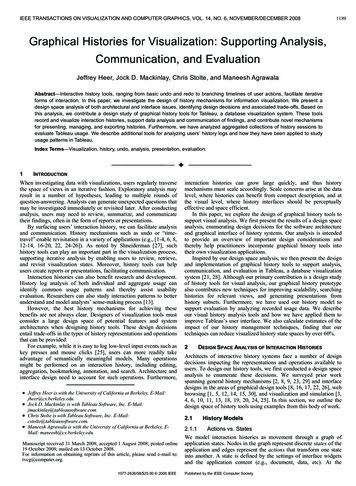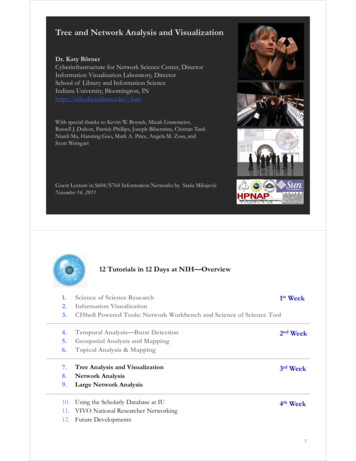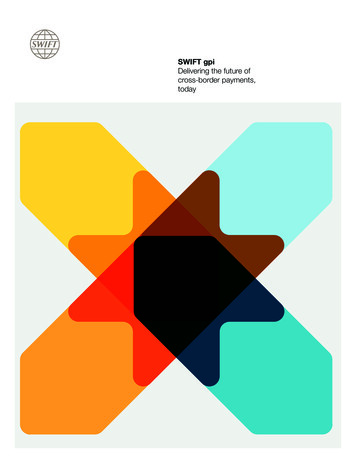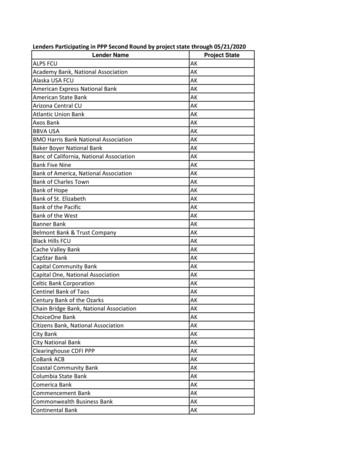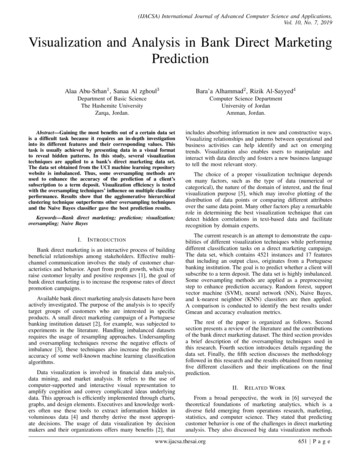
Transcription
(IJACSA) International Journal of Advanced Computer Science and Applications,Vol. 10, No. 7, 2019Visualization and Analysis in Bank Direct MarketingPredictionAlaa Abu-Srhan1 , Sanaa Al zghoul3Bara’a Alhammad2 , Rizik Al-Sayyed4Department of Basic ScienceThe Hashemite UniversityZarqa, Jordan.Computer Science DepartmentUniversity of JordanAmman, Jordan.Abstract—Gaining the most benefits out of a certain data setis a difficult task because it requires an in-depth investigationinto its different features and their corresponding values. Thistask is usually achieved by presenting data in a visual formatto reveal hidden patterns. In this study, several visualizationtechniques are applied to a bank’s direct marketing data set.The data set obtained from the UCI machine learning repositorywebsite is imbalanced. Thus, some oversampling methods areused to enhance the accuracy of the prediction of a client’ssubscription to a term deposit. Visualization efficiency is testedwith the oversampling techniques’ influence on multiple classifierperformance. Results show that the agglomerative hierarchicalclustering technique outperforms other oversampling techniquesand the Naive Bayes classifier gave the best prediction results.Keywords—Bank direct marketing; prediction; visualization;oversampling; Naive BayesI.I NTRODUCTIONBank direct marketing is an interactive process of buildingbeneficial relationships among stakeholders. Effective multichannel communication involves the study of customer characteristics and behavior. Apart from profit growth, which mayraise customer loyalty and positive responses [1], the goal ofbank direct marketing is to increase the response rates of directpromotion campaigns.Available bank direct marketing analysis datasets have beenactively investigated. The purpose of the analysis is to specifytarget groups of customers who are interested in specificproducts. A small direct marketing campaign of a Portuguesebanking institution dataset [2], for example, was subjected toexperiments in the literature. Handling imbalanced datasetsrequires the usage of resampling approaches. Undersamplingand oversampling techniques reverse the negative effects ofimbalance [3], these techniques also increase the predictionaccuracy of some well-known machine learning classificationalgorithms.Data visualization is involved in financial data analysis,data mining, and market analysis. It refers to the use ofcomputer-supported and interactive visual representation toamplify cognition and convey complicated ideas underlyingdata. This approach is efficiently implemented through charts,graphs, and design elements. Executives and knowledge workers often use these tools to extract information hidden involuminous data [4] and thereby derive the most appropriate decisions. The usage of data visualization by decisionmakers and their organizations offers many benefits [2], thatincludes absorbing information in new and constructive ways.Visualizing relationships and patterns between operational andbusiness activities can help identify and act on emergingtrends. Visualization also enables users to manipulate andinteract with data directly and fosters a new business languageto tell the most relevant story.The choice of a proper visualization technique dependson many factors, such as the type of data (numerical orcategorical), the nature of the domain of interest, and the finalvisualization purpose [5], which may involve plotting of thedistribution of data points or comparing different attributesover the same data point. Many other factors play a remarkablerole in determining the best visualization technique that candetect hidden correlations in text-based data and facilitaterecognition by domain experts.The current research is an attempt to demonstrate the capabilities of different visualization techniques while performingdifferent classification tasks on a direct marketing campaign.The data set, which contains 4521 instances and 17 featuresthat including an output class, originates from a Portuguesebanking institution. The goal is to predict whether a client willsubscribe to a term deposit. The data set is highly imbalanced.Some oversampling methods are applied as a preprocessingstep to enhance prediction accuracy. Random forest, supportvector machine (SVM), neural network (NN), Naive Bayes,and k-nearest neighbor (KNN) classifiers are then applied.A comparison is conducted to identify the best results underGmean and accuracy evaluation metrics.The rest of the paper is organized as follows. Secondsection presents a review of the literature and the contributionsof the bank direct marketing dataset. The third section providesa brief description of the oversampling techniques used inthis research. Fourth section introduces details regarding thedata set. Finally, the fifth section discusses the methodologyfollowed in this research and the results obtained from runningfive different classifiers and their implications on the finalprediction.II.R ELATED W ORKFrom a broad perspective, the work in [6] surveyed thetheoretical foundations of marketing analytics, which is adiverse field emerging from operations research, marketing,statistics, and computer science. They stated that predictingcustomer behavior is one of the challenges in direct marketinganalysis. They also discussed big data visualization methodswww.ijacsa.thesai.org651 P a g e
(IJACSA) International Journal of Advanced Computer Science and Applications,Vol. 10, No. 7, 2019for the marketing industry, such as multidimensional scaling, correspondence analysis, latent Dirichlet allocation, andcustomer relationship management (CRM). They debated ongeographic visualization as a relative aspect of retail locationanalysis and tackled the general trade-off between its commonpractices and art. Additionally, they elaborated on discriminantanalysis as a technique for marketing prediction. Discriminantanalysis includes methods such as ensemble learning, featurereduction, and extraction. These techniques solve problemssuch as purchase behavior, review ratings, customer loyalty,customer lifetime value, sales, profit, and brand visibility.Authors of [7] analyzed customer behavior patterns throughCRM. They applied the Naive Bayes, J48, and multi-layerperceptron NNs on the same data set used in the currentwork. They also assessed the performance of their modelusing sensitivity, accuracy, and specificity measures. Theirmethodology involves understanding the domain and the data,building the model for evaluation, and finally visualizing theoutputs. The visualization of their results showed that the J48classifier outperformed the others with an accuracy of 89.40.Moreover, [8] employed the same data set for other customer profiling purposes. Naive Bayes, random forests, anddecision trees were used on the extended version of the data setexamined in the current work. Preprocessing and normalizationwere conducted before evaluating the classifiers. RapidMinertool was used for conducting the experiments and evaluationprocesses. They illustrated the parameter’s adjustments of eachclassifier using a normalization technique applied previously.Furthermore, they showed the impact of these parameter valueson accuracy, precision, and recall. Their results showed thatdecision trees are the best classifier for customer profiling andbehavior prediction.By contrast, [9] used the extended data set to create alogistic regression model for customer behavior prediction.This model is built on top of specific feature selection algorithms. Mutual information (MI) and data-based sensitivityanalysis (DSA) are used to improve the performance overfalse-positive hits. They reduced the number of feature setsinfluencing the success of this marketing sector. They foundthat DSA is superior in the case of low false-positive ratio withnine selected features. MI is slightly better when false-positivevalues are marginally high with 13 selected features among awide range of different features.Additionally, a framework of three feature selection strategies was introduced by [10] to reveal novel features thatdirectly affect data quality, which, in turn, exerts a significantimpact on decision making. The strategies include identification of contextual features and evaluation of historical features.A problem is divided and conquered into sub-problems toreduce the complexity of the feature selection search space.Their framework tested the extended version of the dataset used in the current work. Their goal was to target thebest customers in marketing campaigns. The candidacy ofthe highest correlated hidden features was determined usingDSA. The process involved designing new features of pastoccurrences aided by a domain expert. The last strategy splitthe original data upon the highest relevant set of features.The experiments confirmed the enrichment of data for betterdecision-making processes.From visualization aspects, [11] explained several types ofvisualization techniques, such as radial, hierarchical, graph,and bar chart visualization, and presented the impact of human–computer interaction knowledge on opinion visualizationsystems. Prior domain knowledge yielded high understandability, user-friendliness, usefulness, and informativeness. Agefactor affected the usability metrics of other systems, suchas visual appeal, comprehensiveness, and intuitiveness. Thesefindings were projected to the visualization of the directmarketing industry because it is mainly aided by end usersand customers.III.OVERSAMPLING T ECHNIQUESOversampling is a concept that relates to the handling ofimbalanced datasets. This method is performed by replicatingor synthesizing minority class instances. Common approachesinclude randomly choosing instances (ROS) or choosing special instances on the basis of predefined conditions. Althoughoversampling methods are information-sensitive [12], theyoften lead to the overfitting problem, which may cause misleading classifications. This problem can be overcome by combining oversampling techniques with an ensemble of classifiersat an algorithmic level to attain the best performance.An overview of the oversampling techniques used in thepreprocessing phase of the current research, along with abrief description of the exploited classification algorithm, isintroduced.A. Synthetic Minority Oversampling TechniqueSynthetic minority oversampling (SMOTE) generates synthetic instances on the basis of existing minority observationsand calculates the k-nearest neighbors for each one [13]. Theamount of oversampling needed determines the number ofsynthetic k-nearest neighbors created randomly on the linkline.B. Adaptive Synthetic Sampling TechniqueAdaptive synthetics minority (ADASYN) is an improvedversion of SMOTE. After creating the random samples alongthe link line, ADASYN adds up small values to producescattered and realistic data points [14], which are of reasonablevariance built upon a weighted distribution. This approach isimplemented according to the level of difficulty in learningwhile emphasizing the minority classes that are difficult tolearn.C. Random Over Sampling TechniqueROS is a non-heuristic technique. It is less computationalthan other oversampling methods and is competitive relativeto complex ones [15]. A large number of positive minorityinstances are likely to produce meaningful results under thistechnique.D. Adjusting the Direction of the Synthetic Minority ClassExamples TechniqueAdjusting the direction of the synthetic minority class(ADOMS) examples is another common oversampling technique [15] that relies on the principal component analysiswww.ijacsa.thesai.org652 P a g e
(IJACSA) International Journal of Advanced Computer Science and Applications,Vol. 10, No. 7, 2019of the local data distribution in a feature space using theEuclidean distance between each minority class example and arandom number of its k-nearest neighbors aided by projectionand scaling parameters.E. Selective Preprocessing of Imbalanced Data TechniqueThe selective preprocessing of imbalanced data (SPIDER)technique introduces a new concept of oversampling [16] andcomprises two phases. The first phase is identifying the type ofeach minority class example by flagging them as safe or noisyusing the nearest neighbor rule. The second phase is processingeach example on the basis of one of three strategies; weakamplification, weak amplification with relabeling, and strongamplification.F. Agglomerative Hierarchical Clustering TechniqueAgglomerative hierarchical clustering (AHC) [16] startswith clusters of every minority class example. In each iteration,AHC merges the closest pair of clusters by satisfying somesimilarity criteria to maintain the synthetic instances withinthe boundaries of a given class. The process is repeated untilall the data are in one cluster. Clusters with different sizes inthe tree can be valuable for discovery.IV.C LASSIFICATION T ECHNIQUESIn this section, a concise description of the classificationalgorithms used in this research is presented.A. Random ForestsRandom forest [17] is a supervised learning algorithmused for classification and regression tasks. It is distinguishedfrom decision trees by the randomized process of finding rootnodes to split features. Random forest is efficient in handlingmissing values. Unless a sufficient number of trees is generatedto enhance prediction accuracy, the overfitting problem is apossible drawback of this algorithm.D. Naive BayesNaive Bayes [20] is a direct and powerful classifier thatuses the Bayes theorem. It predicts the probability that a givenrecord or data point belongs to a particular class. The classwith the highest probability is considered to be the most likelyclass. This algorithm assumes that all features are independentand unrelated. The Naive Bayes model is simple and easy tobuild and particularly useful for large data sets. This model isknown to outperform even highly sophisticated classificationmethods.E. K-Nearest NeighborThe KNN learning algorithm is a simple classificationalgorithm that works on the basis of the smallest distance fromthe query instance to the training sample [21] to determine thesimple majority of KNN as a prediction of the query. KNN isused due to its predictive power and low calculation time, andit usually produces highly competitive results.V.V ISUALIZATION M ETHODSData visualization exerts considerable impact on user software experience. The decision-making process benefits fromthe details obtained from large data volumes [22], which areusually built in a coherent and compact manner.The purpose of the established model is to emphasize theimportance of data visualization methods. It helps in conducting a perceptual analysis of a given situation. Visualizationmethods are used to illustrate hidden patterns inside data sets.This section introduces the characteristics of the visualizationmethods used in this research.A. Scatter PlotScatter plots are a graphical display of data dispersionin Cartesian coordinates [22] that shows the strength of relationships between variables and determines their outliers.Variations include scatter plots with trend line. It is used toreveal the patterns in the normal distribution of the data points.B. Support Vector MachinesB. Bar ChartsSVM is a learning algorithm used in regression tasks.However, SVM [18] is preferable in classification tasks. Thisalgorithm is based on the following idea: if a classifier iseffective in separating convergent non-linearly separable datapoints, then it should perform well on dispersed ones. SVMfinds the best separating line that maximizes the distancebetween the hyperplanes of decision boundaries.Bar charts are used to represent discrete single data series [23]. The length usually represents corresponding values.Variations include multi-bar charts, floating bar charts, andcandlestick charts.C. Artificial Neural NetworksANN is an approximation of some unknown functionand is performed by having layers of “neurons” work onone another’s outputs. Neurons from a layer close to theoutput use the sum of the answers from those of the previouslayers. Neurons are usually functions whose outputs do notlinearly depend on their inputs. ANN [19] uses initial randomweights to determine the attention provided to specific neurons.These weights are iteratively adjusted in the back-propagationalgorithm to reach a good approximation of the desired output.C. Pie ChartsA synonym of a circle graph [23] is divided into a numberof sectors to describe the size of a data wedge. Sectors arecompared by using a labeled percentage. Variations includedoughnut, exploding, and multi-level pie charts for hierarchicaldata.D. Line ChartsLine charts visualization technique [23] is used to displaythe trend of data as connected points on a straight line over aspecific interval of time. Variations include step and symbolicline charts, vertical–horizontal segments, and curve line charts.www.ijacsa.thesai.org653 P a g e
(IJACSA) International Journal of Advanced Computer Science and Applications,Vol. 10, No. 7, 2019VI.DATA S ET AND M ETHODOLOGYA. DataSetThe data set is obtained from the UCI machine learningrepository. This data set is related to the direct marketingcampaigns of a Portuguese banking institution. The currentresearch uses the small version of the raw data set, whichcontains 4521 instances and 17 features (16 features andoutput). The classification goal is to predict whether the clientwill subscribe (yes/no) to a term deposit (variable y). TableI shows the dataset description, and Fig. 1 illustrates thedistribution of each feature.Fig. 2 shows the relationship between each attribute andthe output. The attribute with unique values (distribution) ofless than 6 is selected.TABLE I. ATTRIBUTE I yspreviouspoutcomeoutDescriptionAgeType of jobMarital statusEducationHas credit in defaultCredit balanceHas housing loanHas personal loan?Contact communication typeLast contact day of the weekLast contact month of YearLast contact duration, in secondsNumber of contacts performed during thiscampaign and for this clientNumber of days that passed by after the clientwas last contacted from a previous campaignNumber of contacts performed before thiscampaign and for this clientOutcome of the previous marketing campaignhas the client subscribed a term depositUnique Values671234223532233112875322922442Fig. 2. Pie Chart Visualization Method for Features DistributionFig. 1. Features DistributionFig. 2 shows the relationship between each attribute andthe output. The attribute that has unique values (distribution)less than 6 is selected.www.ijacsa.thesai.org654 P a g e
(IJACSA) International Journal of Advanced Computer Science and Applications,Vol. 10, No. 7, 2019According to the distribution of the target class shown inFig. 3 and 4, the data set is imbalanced. That is, the percentageof class yes is 11.5 (500 records out of 4521), whereas that ofclass no is 88.5 (4021 records out of 4521).TABLE II. G MEAN AND ACCURACY OF D IFFERENT C LASSIFICATIONT ECHNIQUES AFTER USING SMOTE OVERSMPLING T ECHNIQUE WITHP ERCENTAGE 100MethodRandom forestSVMNNnaive bayesK nearest 889.3887.63585.1185.02TABLE III. R ESULTS OF D IFFERENT C LASSIFICATION T ECHNIQUES ONTHE O RIGINAL DATASET (G MEAN ,ACCURACY )MethodRandom forestSVMNNNaive BayesK nearest neighborFig. 3. Pie Chart Visualization Method for Output 89.2988.1886.8886.5The best results with Naive Bayes are those with a SMOTEvalue set to 400, as shown in Fig. 5. The figure also showsthe Gmeans of different SMOTE percentages using the NaiveBayes classifier. The results in Table IV are shown as a chartto present a clear reading of the best Gmean.Fig. 4. Bar Chart Visualization Method for Output DistributionB. MethodologyA preprocessing phase is first implemented to balance thedata distribution by applying oversampling techniques, suchas SMOTE with varying percentages. The next step is todetermine which among ADASYN, ROS, SPIDER, ADOMS,and AHC is superior. The selection is aided by proper visualization methods. Then, random forest, SVM, ANN, NaiveBayes, and KNN classification algorithms are applied, andtheir assessment is conducted using Gmean as an evaluationmetric. Other essential measurements, such as accuracy andrecall, are also used.VII.R ESULTS AND D ISCUSSIONIn the preprocessing step, the SMOTE percentage is setto 100. Gmean and accuracy are calculated for differentclassifiers. Table II shows the results.Accordingly, the Naive Bayes technique has the highestGmean among all techniques. The accuracy and Gmeans ofall five classifiers in the original dataset are shown in TableIII.Fig. 5. Gmean of Naive Bayes with Different SMOTE Percentages Rangingfrom 100 to 800Another experiment is conducted to determine the secondbest classifier under SMOTE set to 400. Table V shows theresults. As shown in Fig. 6, the best classifier is the one withthe highest Gmean, that is, Naive Bayes and SVM with aGmean value of 0.74.SVM and Naive Bayes are good candidates for furtheranalysis. Naive Bayes is preferred over SVM because it isfast and easy to install. Fig. 6 shows the Gmean value beforeand after applying SMOTE. SMOTE enhances the Gmeans forall applied classification techniques.The final step is to compare oversampling techniques withTABLE IV. G MEAN AND ACCURACY OF NAIVE BAYES WITH D IFFERENTSMOTE P ERCENTAGES R ANGING FROM 100 TO 800Then, Naive Bayes with different SMOTE percentages isapplied to select the most appropriate one that throws thebest results from this data set. Table IV shows the results ofNaive Bayes on the data set with different SMOTE percentagesranging from 100 to 8655 P a g e
(IJACSA) International Journal of Advanced Computer Science and Applications,Vol. 10, No. 7, 2019TABLE V. ACCURACY AND G MEAN OF DIFFERENT TECHNIQUES USINGSMOTE WITH PERCENTAGE 400MethodRandom forestSVMNNnaive bayesK nearest 86.9280.8083.98Fig. 6. Gmean of different techniques using SMOTE with percentage 400compared with originalthe best SMOTE percentage. Comparing these results withthose of the original dataset is also important. Naive Bayes isused with all oversampling techniques. Accuracy and Gmeanare calculated by different percentages of SMOTE. Table VIshows the results.The scatter plot method is used to visualize the results ofthe six oversampling techniques, as illustrated in Fig. 7.TABLE VI. C OMPARISON B ETWEEN D IFFERENT OVERSAMPLINGT ECHNIQUES (P ERCENTAGES R ANGING FROM 100 TO 9677.1877.6376.15Table VII shows the best percentage for all used oversampling techniques. Apart from the Gmean and accuracy of thebest percentage of each oversampling technique used, Fig. 8shows the final results. Oversampling techniques are found toenhance performance. AHC with Naive Bayes has the bestGmean among all the oversampling techniques.VIII.Fig. 7. Gmean of Different Oversampling Techniques with DifferentPercentages Ranging from 100 to 400C ONCLUSIONThis research aimed to provide a visualization mechanismfor simple classification tasks. Experiments were conducted onan imbalanced data set for a direct marketing campaign of awww.ijacsa.thesai.org656 P a g e
(IJACSA) International Journal of Advanced Computer Science and Applications,Vol. 10, No. 7, 2019TABLE VII. C OMPARISON B ETWEEN D IFFERENT OVERSAMPLINGT ECHNIQUES WITH B EST G MEAN P ERCENTAGETechniqueBest ve Bayes ][9][10][11]Fig. 8. Gmean of Different Oversampling Techniques Compared withOriginal[12]Portuguese bank institution. The goal was to predict whethera customer will subscribe to a term deposit. The experimentswere conducted using different oversampling techniques, alongwith five selected common classifiers from the literature. Theresults showed that AHC with SMOTE of 500 outperformedthe other oversampling techniques. The Naive Bayes andSVM classifiers provided the best prediction accuracy andGmean values. Naive Bayes was preferred for its simplicityand maintainability. This research is limited to the applying ofthe most used oversampling techniques and it only performedon the small version of the direct marketing campaign of aPortuguese banking institution. Also, not all known classifiersinvolved in conducting the experiments, nor the visualizationtechniques and the results can be further analyzed by otherperformance measurements to draw more precise conclusions.[13][14][15][16][17][18]R EFERENCES[1][2][3][4][5]V. L. Miguéis, A. S. Camanho, and J. Borges, “Predicting direct marketing response in banking: comparison of class imbalance methods,”Service Business, vol. 11, no. 4, pp. 831–849, 2017.S. Ghosh, A. Hazra, B. Choudhury, P. Biswas, and A. Nag, “A comparative study to the bank market prediction,” in International Conference onMachine Learning and Data Mining in Pattern Recognition. Springer,2018, pp. 259–268.G. Marinakos and S. Daskalaki, “Imbalanced customer classification forbank direct marketing,” Journal of Marketing Analytics, vol. 5, no. 1,pp. 14–30, 2017.J. Kokina, D. Pachamanova, and A. Corbett, “The role of data visualization and analytics in performance management: Guiding entrepreneurialgrowth decisions,” Journal of Accounting Education, vol. 38, pp. 50–62,2017.G. Costagliola, M. De Rosa, V. Fuccella, and S. Perna, “Visual languages: A graphical review,” Information Visualization, vol. 17, no. 4,pp. 335–350, 2018.[19][20][21][22][23]S. L. France and S. Ghose, “Marketing analytics: Methods, practice,implementation, and links to other fields,” Expert Systems with Applications, 2018.S. S. Raju and P. Dhandayudam, “Prediction of customer behaviouranalysis using classification algorithms,” in AIP Conference Proceedings, vol. 1952, no. 1. AIP Publishing, 2018, p. 020098.S. Palaniappan, A. Mustapha, C. F. M. Foozy, and R. Atan, “Customerprofiling using classification approach for bank telemarketing,” JOIV:International Journal on Informatics Visualization, vol. 1, no. 4-2, pp.214–217, 2017.N. Barraza, S. Moro, M. Ferreyra, and A. de la Peña, “Mutualinformation and sensitivity analysis for feature selection in customertargeting: A comparative study,” Journal of Information Science, p.0165551518770967, 2018.S. Moro, P. Cortez, and P. Rita, “A framework for increasing the valueof predictive data-driven models by enriching problem domain characterization with novel features,” Neural Computing and Applications,vol. 28, no. 6, pp. 1515–1523, 2017.K. Sagar and A. Saha, “A systematic review of software usabilitystudies,” International Journal of Information Technology, pp. 1–24,2017.F. Shakeel, A. S. Sabhitha, and S. Sharma, “Exploratory review on classimbalance problem: An overview,” in Computing, Communication andNetworking Technologies (ICCCNT), 2017 8th International Conferenceon. IEEE, 2017, pp. 1–8.D. Elreedy and A. F. Atiya, “A novel distribution analysis for smoteoversampling method in handling class imbalance,” in InternationalConference on Computational Science. Springer, 2019, pp. 236–248.Y. E. Kurniawati, A. E. Permanasari, and S. Fauziati, “Adaptivesynthetic-nominal (adasyn-n) and adaptive synthetic-knn (adasyn-knn)for multiclass imbalance learning on laboratory test data,” in 2018 4thInternational Conference on Science and Technology (ICST). IEEE,2018, pp. 1–6.M. S. Santos, J. P. Soares, P. H. Abreu, H. Araujo, and J. Santos,“Cross-validation for imbalanced datasets: Avoiding overoptimistic andoverfitting approaches [research frontier],” ieee ComputatioNal iNtelligeNCe magaziNe, vol. 13, no. 4, pp. 59–76, 2018.S. Fotouhi, S. Asadi, and M. W. Kattan, “A comprehensive datalevel analysis for cancer diagnosis on imbalanced data,” Journal ofbiomedical informatics, 2019.Z.-H. Zhou and J. Feng, “Deep forest,” arXiv preprintarXiv:1702.08835, 2017.G. Haixiang, L. Yijing, J. Shang, G. Mingyun, H. Yuanyue, andG. Bing, “Learning from class-imbalanced data: Review of methodsand applications,” Expert Systems with Applications, vol. 73, pp. 220–239, 2017.W. Cao, X. Wang, Z. Ming, and J. Gao, “A review on neural networkswith random weights,” Neurocomputing, vol. 275, pp. 278–287, 2018.J. Korst, V. Pronk, M. Barbieri, and S. Consoli, “Introduction toclassification algorithms and their performance analysis using medicalexamples,” in Data Science for Healthcare. Springer, 2019, pp. 39–73.J. Gou, H. Ma, W. Ou, S. Zeng, Y. Rao, and H. Yang, “A generalizedmean distance-based k-nearest neighbor classifier,” Expert Systems withApplications, vol. 115, pp. 356–372, 2019.M. Behrisch, M. Blumenschein, N. W. Kim, L. Shao, M. El-Assady,J. Fuchs, D. Seebacher, A. Diehl, U. Brandes, H. Pfister et al., “Qualitymetrics for information visualization,” in Computer Graphics Forum,vol. 37, no. 3. Wiley Online Library, 2018, pp. 625–662.K. Santhi and R. M. Reddy, “Critical analysis of big visual analytics:A survey,” in 2018 IADS International Conference on Computing,Communications & Data Engineering (CCODE),
the original data upon the highest relevant set of features. The experiments confirmed the enrichment of data for better decision-making processes. From visualization aspects, [11] explained several types of visualization techniques, such as radial, hierarchical, graph, and bar chart visualization, and presented the impact of hu-




